|
Related FAQs: Fishes of
Hawai'i, Articles on: The Best
Butterflyfishes of Hawai'i, Triggerfishes of
Hawai'i,
Related Articles: A
Fishwatcher's Guide to the Marine Aquarium Fishes of
Hawai'i, Introduction to
Fishwatcher's Guide Series
Pieces/Sections, Scott's Trip to
Maui/Hawai'i, Holualoa property,
A Fishwatcher's Guide to the
Marine Invertebrates of Hawai'i
Part 2 of 4, To: Part 1,
Part 3, Part 4,
|
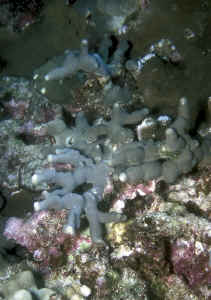
|
|
Bob Fenner
|
Porites compressa
|
Stinging Celled Animals, Phylum Cnidaria
Hydroids and Siphonophores:
| Gymnangium hians (Busk 1852), Feather
Hydroid. Found in areas of good current on underhangs, in caves
(pukas). Gray to light brown in color. 2-3 inches in length.
Indo-Pacific. Hawaii pix. |
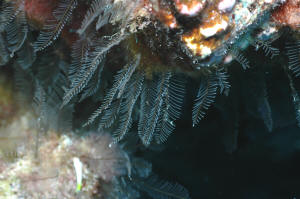
|
| Pennaria disticha Goldfuss 1820.
Cosmopolitan in tropical, temperate seas. To 12 cm. in height.
Urn-shaped polyps are born on upper sides of immediately
alternating branches. N. Sulawesi and Nuka Hiva, Marquesas
images. |
 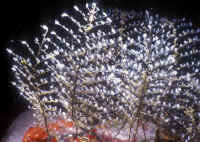
|
Zoanthids: Colonial Anemones
| Palythoa caesia Dana 1848. Rubbery
appearing common mat, flattened polyps exposed to varying degrees
to 3 cm. diameters. Tentacle ends look like knobs. Dark brown to
tan in color. Western Pacific. Hawai'i pix. |
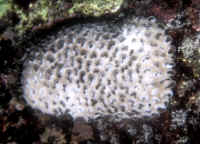 
|
Soft Corals:
| Anthelia edmondsonii (Verrill 1928). Light
blue in color this is one of the few soft corals found in
Hawai'i (and only there). Predated nightly by the nudibranch
Tritonia hawaiiensis. 1/4" inch across polyps in
colonies 3-12" across. Big Island photos. |
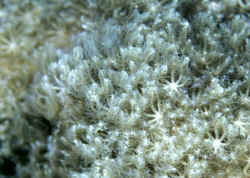 
|
| Sinularia abrupta Tixier-Durivault 1970,
Leather Coral. Western and Central Pacific. Easy to miss in the
wild. Short (two inch maximum height), flexible lobes on a flat
base. Image shot at Shark Point, O'ahu, Hawai'i. |
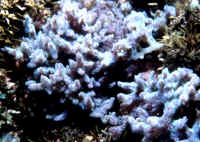
|
Stony Corals:
Where's the group spiel Bob? Oh, saving it
for the tome "Hawai'i Underwater" guide I see...
Family Acroporidae:
| Montipora capitata (Dana 1846), Rice
Coral. Encrusting to massive colonies to thin plates in calm water.
Dark to light brown in color. Hawaiian endemic. Structural
elements of polyps appear like grains of rice. |
 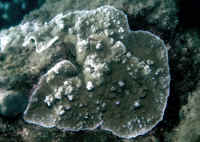
|
| Montipora flabellata Studer 1901, Most
colonies are fluorescent blue to purplish in color, though they can
be brown. Shallow water (to 20 feet). Hawaiian
endemic. |
 
|
Family Agariciidae: Elephant Skin Corals. Ridges of
corallites (the septo-costae) interconnect adjacent calyces. Have very
short tentacles and therefore are thought to feed more by mucus
entrapment of suspended material than by stinging collection. Genus
Leptoseris: Six Hawaiian species (three deepwater). Septa are long,
fine and generally curved. Genus Pavona (three local species),
septa are shorter and straight.
| Leptoseris incrustans (Quelch 1886),
Swelling Coral. Most common member of the genus in Hawai'i.
Identified by swellings of septo-costae between the calyces.
Colonies of only a few inches across occur under ledges, generally
in deeper water. Tan to reddish-brown to greenish in color.
Indo-Pacific. Kona, HI pic. |
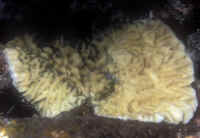 
|
| Leptoseris hawaiiensis Vaughan 1907.
Colonies as encrusting laminae. Corallites raised irregularly,
rounded. Septae costae even. Green or brown in color. East Africa,
Red Sea to Hawai'i, Tuamotus and tropical East Pacific. Nuka
Hiva, Marquesas, Polynesia pic. |
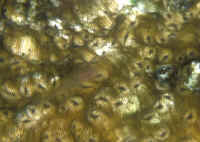
|
| Pavona duerdeni Vaughan 1907. Massive
colonies (up to 10 feet tall) of irregular appearance (sometimes
huge). Red Sea and Hawai'i images. Found in areas of
moderate current, wave movement Named in honor of cnidarian
scientist J. E. Duerden (1865-1937). |
 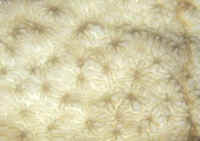
|
| Pavona varians Verrill 1864. Colonies
encrusting to laminar, showing short, irregular valleys.
Hawai'i images. |
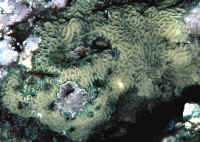 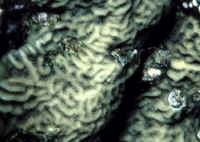
|
Family Pocilloporidae: Cat's Paw Corals. Have bumpy
appearance due to raised verrucae.
| Pocillopora damicornis (Linnaeus 1758),
Cauliflower Coral. The most common member of the family offered to
the aquarium trade. Compact clumps of up to a few meters height.
Verrucae and branches blend together. Of varying branch thickness
(thinner in greater depths, less water motion areas). Several
colors: overall brown, pink cream, greenish. Colony and close-up of
Pulau Redang specimens and close-up of the species off Cabo Pulmo,
Mexico's Sea of Cortez in the tropical eastern Pacific
below. |
| Pocillopora eydouxi Milne Edwards &
Haime 1860, Brush Coral. Distinctive large, upright branches with
light-colored ends. A common species over its wide range.
Shown in Hawai'i. |
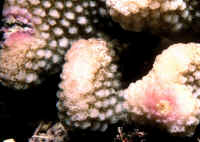 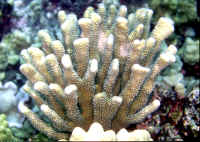
|
| Pocillopora meandrina Dana 1846. Flat,
short, curved branches, small verrucae. Regular arrangement of
branch growth, verrucae placement. At right:
Bunaken/Sulawesi/Indo. and Hawai'i close-ups, and two
images of this common species in Hawai'i below. |
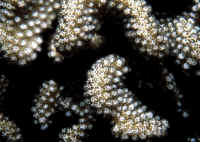 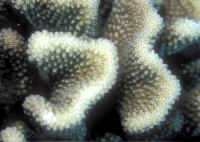
|
Family Poritidae:
| Porites compressa Dana 1846, Finger Coral.
Another common (endemic) species in Hawai'i (85% or so of
Kaneohe Bay, O'ahu). Generally light brown in color.
Finger like deeper, to knobby boulders in shallow. Below, shallow
to deeper pics. |
| Porites evermanni Vaughan 1907,
Evermann's Coral. A massive form that is sometimes similar to
P. lobata (below), but never yellow in color (brown to gray
to purple). Commonly knobby and fuzzy at close inspection (the
latter due to partly retracted polyps). Likely endemic to
Hawai'i. Image with P. lobata in background. |
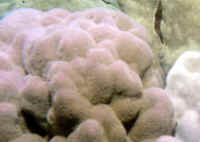 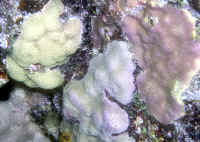
|
| Porites lobata Dana 1846, Lobe Coral. The
most common coral species in Hawai'i. Found as encrusting
colonies in high wave action areas to fifteen foot high mounds in
protected areas. Yellow to greenish in color. Often with grooves
caused by the Snapping Shrimp Alpheus deuteropus. Below:
close up of an encrusting colony, one showing shrimp space parasite
marking (both Hawai'i) and a huge colony (grow about an inch
tall per year) in the Maldives. At right, Hawaiian specimen with
pink worm parasites (Trematode, flatworm) that Butterflyfishes pick
at, consume, continuing the life cycle. |
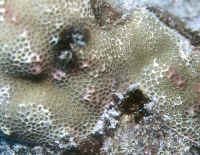
|
| Porites rus Forsskal 1775, Plate and Pillar
Coral. Variable in shape as its common name points to. Upright
columns more shallow to gorgeous plates deeper, more calm waters.
Gray to brown in color, often with yellow polyps that have wider
spaced calyces, raised areas between polyps. Both morphs visible
here at Honaunau, City of refuge, Kailua, Kona, Hawai'i. |
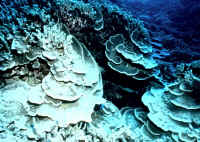
|
Family Fungiidae: Plate Corals: Seven species, three
genera recorded from Hawai'i
| Cycloseris vaughani
Boschma 1923, Vaughan's Razor Coral. Circular in shape, flat on
the bottom. Found on hard surfaces in shallow depths (to forty feet
or so). Six prominent septal ribs. Big Island pic. |
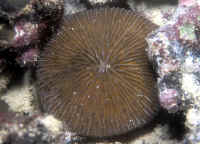
|
| Fungia concinna Verrill 1864, Disk Coral.
Flat, circular skeletons to six inches in diameter. Septal teeth
small. Very small tentacular lobes or none. Underside lacks
pits. Here off Hawai'i's Big Island at
night. |

|
| Fungia scutaria Lamarck 1801. Oval, heavy
polyps with high, regularly placed tentacular lobes. To seven
inches. Indo-Pacific. Occur in many colors. Largest, most common
fungiid in Hawai'i. |
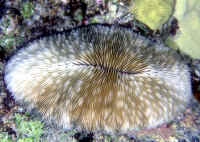
|
Family Agariciidae:
| Leptoseris hawaiiensis Vaughan 1907.
Colonies as encrusting laminae. Corallites raised irregularly,
rounded. Septae costae even. Green or brown in color. East Africa,
Red Sea to Hawai'i, Tuamotus and tropical East Pacific. Nuka
Hiva, Marquesas, Polynesia pic. |

|
| Pavona duerdeni Vaughan 1907. Massive
colonies of irregular appearance (sometimes huge). Red Sea
image. |

|
| Pavona varians Verrill 1864. Colonies
encrusting to laminar, showing short, irregular valleys.
Hawai'i images. |
 
|
Family Faviidae: Honeycomb Corals
| Leptastrea purpurea (Dana 1846). Crust
Coral. Encrusting to lobe-like. Large (1/8") calyces with
walls touching. Indo-Pacific. Here in Hawai'i. |

|
Family Dendrophylliidae:
| Balanophyllia sp. Either B. hawaiiensis or
B. cf. affinis. Here off Hawai'i's Big Island at night,
though can be found in caves and crevices open during daylight
hours. About one inch in all dimensions. |

|
| Tubastrea coccinea Lesson 1831, Orange
Cup Coral. Caribbean and Indo-Pacific. Right: Closed, open colony
pix in the Bahamas. Below, close up of a colony under an arch off
of Kailua Kona and exhibit images shot at the Waikiki
Aquarium. |
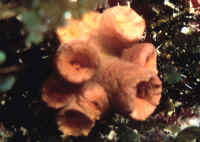 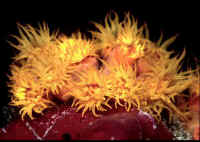
|
Order Antipatharia: Black Corals, Whip Corals
| Cirripathes anguina Dana 1846, Common Whip
Coral. Often twisted on its singular axis. Polyps arrayed on two
opposing sides of skeleton. Hawaiian Whip Corals are commensal
hosts to two species of gobies (which often denude the anterior tip
to lay their eggs) and two species of pontonid shrimp. Found in
forty plus foot depths, sticking out into currents. Up to three
feet in length. Kona pix. |

|
Worms:
Flatworms:
| Pseudoceros dimidiatus von Graff 1893. Look
for the double yellow "racing stripe" down the middle for
this species. Other markings are variable to missing. Central
to western Pacific. This one off of Kailua Kona,
Hawai'i. |

|
| Pseudoceros ferrugineus Hyman 1959. The
Fuchsia Flatworm Central and Western Pacific at moderate depths.
Out during both day and night, often appearing bluish until
artificial light is applied, and more round when fully opened.
Hawaii pix. |
 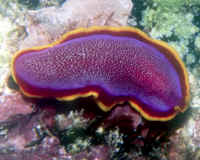
|
Polychaete Worms:
| Sabellastarte sanctijosephi (Gravier 1908).
Indo-Pacific; Eastern Africa to the Cook Islands. Image shot off of
Hawai'i, Malaysia. Characterized by their two tentacular crown
head. |
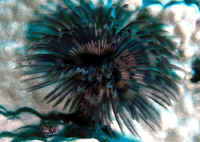
|
| Spirobranchus giganteus Pallas 1766, Horned
Christmas Tree, aka Bisma Rock Worms. Cosmopolitan; all tropical
seas. Most often found in association (burrowed in) Porites and
Millepora. To an inch in diameter. Hard to maintain in captivity
over any period of time. Need frequent particulate feedings, low
light. Pulau Redang, Malaysia photo. |
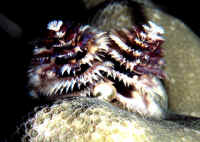
|
| Loimia medusa (Savigny 1820), the Medusa or
Spaghetti Worm. Cosmopolitan; all tropical seas. Found between
rocks in silt to sandy substrates. Tube-dwelling (family
Terebellidae) worm that is most often recognized by its extended
feeding tentacles. Hawai'i image. |
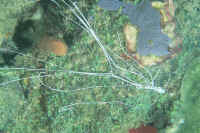
|
Bryozoans:
| Crisina radians (Lamarck 1816), the Tuning
Fork Bryozoan. A calcareous species found on hard surfaces and
seaweed blades. Ends of colonies look like tuning forks. To about a
half inch across. Kona, Hawai'i. images. |
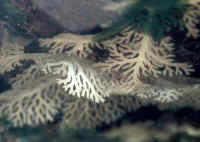 
|
| Triphyllozoon sp. perhaps T.
inornatum Harmer 1934. Found on walls in areas of high current.
Hydroid polyps with capitate tentacles. Western Pacific; New
Guinea, Indonesia, Philippines. N. Sulawesi and Hawai'i
images. |
 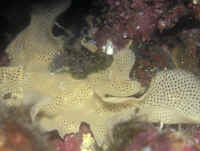
|
Mollusks:
Gastropods:
Nerites & Periwinkles: Families Neritidae and
Littorinidae
| Nerita picea (Recluz 1841), the Black Nerite
(Pipipi in Hawaiian). A Hawaiian endemic. To about a half
inch in length. Found in the splash zone to high and dry above
there (but below Periwinkles), more actively grazing at night.
Shiny black globose shells with fine gray spiral lines. |

|
Family Hipponicidae: Hoof Shells. Attach limpet-like to the
substrate and don't move. Unlike true limpets (family Patellidae)
these snails show spiral growth in their shells. Four Hawaiian
species.
| Hipponix imbricatus Gould 1846. Shingly Hoof
Shell. At times very abundant on the outsides of smooth boulders.
Shallows to about fifty feet of depth. May be endemic to
Hawai'i. To about half an inch in diameter. |
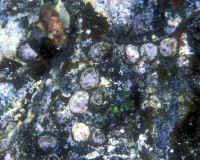
|
Families Ranellidae and Personidae (often in Cymatidae in older
literature): Tritons. Usually have thick, heavy, sculptured shells,
though their beauty is often hidden by growth of their periostracum.
Feed on echinoderms and molluscs. Fourteen species in
Hawai'i.
| Charonia tritonis (Linnaeus 1767), the
Triton's Trumpet (or Pu ole in Hawaiian). To twenty inches. .
Indo-Pacific. Used by the Greek God Triton as well as Hawaiian and
other indigenous folks as a blow horn. Important as a predator on
Crown of Thorns Stars as well as other echinoderms. Hawai'i
pic. |
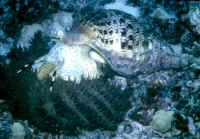 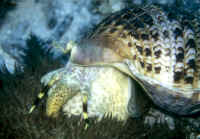
|
Cowries, Family Cypraeidae
| Cypraea species (not all...) Cypraea annulus
Linnaeus 1758, the Gold Ringed Cowry (family Cypraeidae). A great
animal for reef aquariums with algae to trim! Flattened top with
bright golden rim... similar to the Money Cowry (C. moneta).
Indian Ocean, Red Sea, to Central Pacific, including
Hawai'i's leeward islands and the Cooks. To about half an
inch in length. This one in my friend Maurice's tank at
home! |
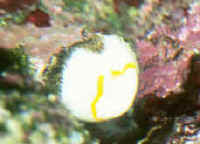
|
| Cypraea caputserpentis Linnaeus 1758, the
Snakehead Cowry. Indo-Pacific, including Hawai'i. To about an
inch and a half in shell length. This one off of Maui,
Hawai'i. |

|
| Cypraea maculifera Schilder 1932, the
Reticulated Cowry. Shallow water to fifty feet, in cracks and
crevices, usually in caves. Common throughout its range in the
Central Pacific. To 2 1/2". This one in Hawaii. |

|
| Cypraea tigris Linnaeus 1758, the Tiger
Cowry. Too common as a "curio", this is no doubt the best
know Cowry (or at least most recognized as a sea animal in the
group). South Africa, Red Sea, Hawai'i, Society Islands. To
four inches shell length. One off the Gilis, Lombok, Indonesia,
another with a flashlight for size comparison where they "come
the biggest", off of Hawai'i. |
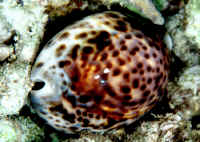 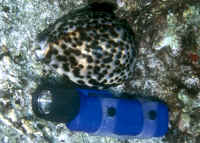
|
Family Casididae: Helmets. Generally large shelled animals
with a short spire (the upper end of shell whorls and apex). Helmet
shells have a long aperture that sports a groove that the siphon lays
in and protrudes. They feed on urchins, both heart and spiny ones...
that the spines are of no concern. Four species in
Hawai'i.
| Cassis cornuta (Linnaeus 1758), the Horned
Helmut. One of four species found in Hawai'i. Common in shallow
sandy environments. Found buried in sand with only whorls in
evidence. Largest Hawai'ian Helmut (to 15"); used as a
"blow horn" by natives in shows. Some authors believe
specimens with fewer, higher horns are males, shorter, more
numerous females. Kona pix. |
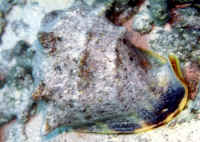 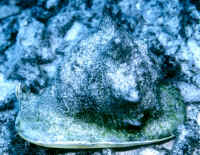
|
Family Conidae: (Superfamily Conacea, Toxoglossa). Predaceous
species with a toxoglossal radula or none, associated with poison
glands. The Cone Shells (Conus, Turris) and highly spired Terebridae
(Terebra). Don't touch!
| Conus abraeus Linnaeus 1758, the Hebrew
Cone. Indo-Pacific. To 2 1/2" in length. Found exposed by day
in sandy areas feeding on polychaete worms. Distinctive
"Hebrew lettering" on heavy white shells. When alive the
shell is covered with a yellowy periostracum. Kona
photo. |
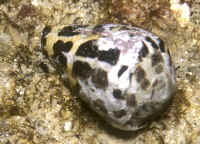
|
| Conus marmoreus Linnaeus 1758, the Marbled
Cone. Indo-Pacific. To 5" in length. Found at times exposed by
day in sandy areas feeding on other cones. This is one of a few
toxic/venomous cone species in Hawai'i. Cannot be handled
anywhere safely. Kona photo. |
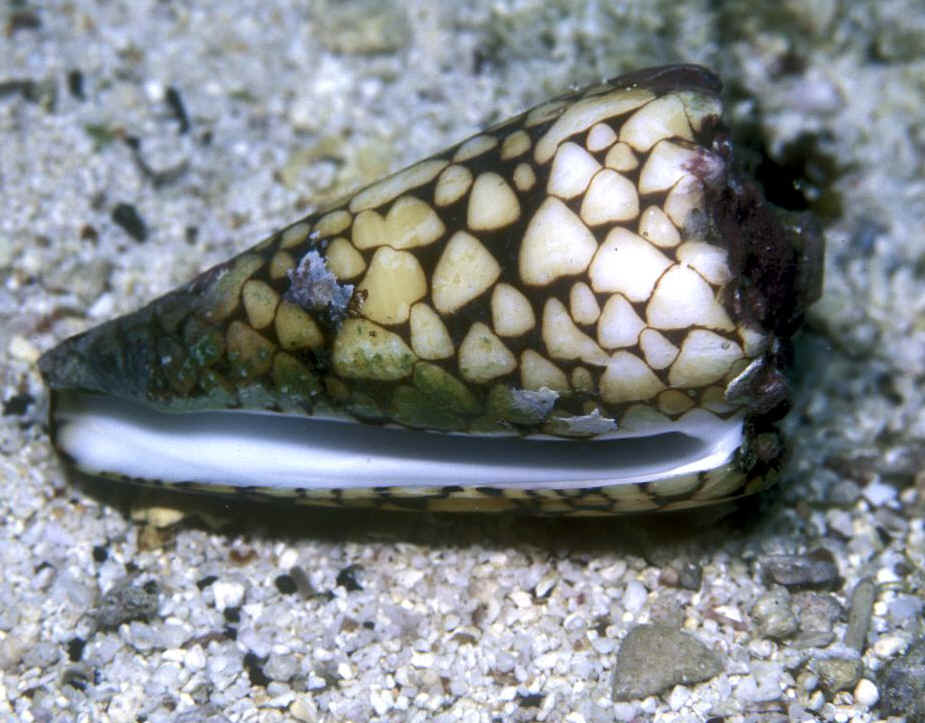
|
| Conus textile Linnaeus 1758, the Textile
Cone. Indo-Pacific; Red Sea, much of the rest of the tropical
Indo-Pac, including Hawai'i. Feeds on other prosobranch snails.
Can be fatal to humans. Red Sea image. |
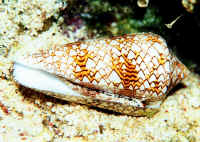
|
Nudibranchs:
| Dendrodoris tuberculosa (Quoy & Gaimard
1832), the Tuberculous Nudibranch. Indo-Pacific. To six inches in
diameter. Broadly roundish, flat in profile with rosette like
structure over the dorsum. Reportedly produces substance/s that
cause eye irritation if handled. Hawai'i (Kona) photo. Live in
exposed rock areas with good sponge cover. |
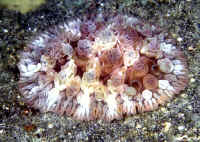
|
| Halgerda terramtuentis Bertsch & Johnson
1982, the Gold Lace Nudibranch. Hawaiian endemic. Michelle Lemech
photo taken there. |
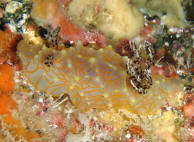
|
| Phyllidia varicosa. Red Sea to Hawai'i.
To nearly three inches in length. In
Hawai'i. The latter about three inches in length.
Hawai'i pix of a single individual and a
pair. |
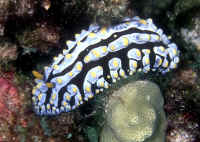 
|
| Phyllidiella pustulosa (Cuvier 1804). Black
body with pink tuberculations arranged in rows to clusters. Common
from the Red Sea to Hawai'i. One in Fiji, another in
Hawai'i. |
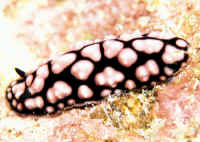 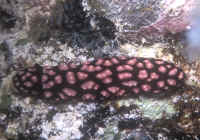
|
| Pteraeolidia ianthina (Angas 1864). Sea
Dragon. Mauritius, East Africa to Australia, Japan over to
Hawai'i. To 15 cm. Photosynthetic via endosymbiotic
zooxanthellae, harvested initially be eating hydroids. Indonesia
and Hawai'i at right. |
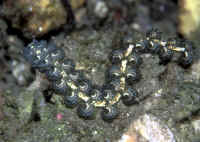 
|
To: Part 1, Part
3, Part 4,
|
|

